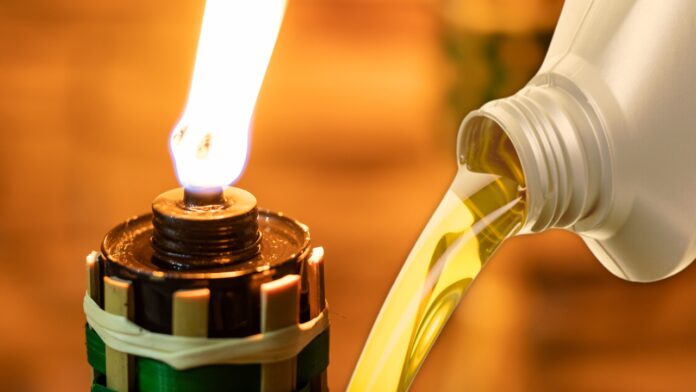Lamp oil is a term used to describe a combustible liquid that is typically burned in lamps. While lamp oil can be used for a number of different purposes, it is important to dispose of it properly when you are finished using it.
This blog post will provide some tips on How To Dispose Of Lamp Oil safely and responsibly. By following these simple steps, you can help protect our environment and keep our waterways clean!
What Is Oil Lamp:
An oil lamp is any type of lamp that uses oil as fuel. Oil lamps have been used throughout history as a primary form of lighting.
Early oil lamps were simple clay pots or bowls with a wick emerging from the center. The wick was soaked in oil and then lit, creating a small flame.
What Type Of Fuels Used In Oil Lamps:
There are a variety of different oils that can be used as fuel for oil lamps. The most common type of oil used is lamp oil, which is a highly refined petroleum product. Other options include.
1. Kerosine:
Kerosine is a light petroleum distillate that is used in many types of lamps, heaters, and stoves. It is also known as paraffin oil.
2. Vegetable Oil:
Many people choose to use vegetable oil in their oil lamps because it is a renewable resource. However, it is important to note that vegetable oil can go bad, so it should be replaced regularly.
3. Olive Oil:
Olive oil is another popular choice for oil lamps. It burns cleanly and has a pleasant smell. However, it is also a bit more expensive than other types of oil.
4. Mineral Oil:
Mineral oil is a non-renewable resource, but it is very effective as a fuel for oil lamps. It burns cleanly and is relatively inexpensive.
5. Animal Fat:
Animal fat can also be used as fuel for oil lamps. However, it can produce a smoky flame, so it is not the best option for indoor use.
please also check: Best Uv Lamp For Gel Nails
How to Dispose of Oil Lamp:
When you are finished using your oil lamp, it is important to properly dispose of the lamp oil and wick. Here are some tips on how to do this:
1. Soak:
The first step is to soak the wick in water. This will help to remove any excess oil.
2. Clean:
After the wick has been soaked, use a brush or cloth to clean it. This will help to remove any residue that may be left behind.
3. Dispose:
Once the wick is clean, you can dispose of it in the trash. Be sure to properly seal the container before disposing of it.
4. Recycle:
The oil from your lamp can be recycled and used again. There are a number of companies that will recycle lamp oil.
By following these simple steps, you can safely and responsibly dispose of your oil lamp. By doing so, you will help to protect our environment and keep our waterways clean!
Preventions Of Disposing Oil Lamps:
1. Pouring Oil Down The Drains:
This is the most common mistake people make when disposing of their oil lamps. Pouring oil down the drain can contaminate soil and water supplies.
2. Throwing The Oil In The Trash:
While this may seem like an easy way to get rid of your oil, it can actually be very dangerous. If the oil is not properly sealed, it can leak and cause a fire.
3. Burning:
Burning the oil from your lamp is not a safe way to dispose of it. The flame can be difficult to control and it can produce harmful smoke.
4. Storing:
Storing the oil from your lamp is not a safe option. If the oil is not properly sealed, it can leak and cause a fire.
5. Reusing:
Reusing the oil from your lamp is not a safe option. The oil can be contaminated with toxins that can be harmful to your health.
Benefits Of Owning Oil Lamp:
There are a number of benefits to owning an oil lamp.
1. Oil Lamps Are A Renewable Source Of Light:
Oil lamps can be used over and over again, making them a renewable source of light.
2. Oil Lamps Are Very Efficient:
Oil lamps are very efficient, meaning they produce a lot of light for the amount of oil used.
3. Oil Lamps Are Very Safe:
When used properly, oil lamps are very safe. They do not produce any harmful smoke or chemicals.
4. Oil Lamps Are Very Inexpensive:
Oil lamps are very inexpensive, especially when compared to other sources of light such as electric lights.
Drawbacks Of Owning Oil Lamps:
1. Oil Lamps Require Regular Maintenance:
Oil lamps require regular cleaning and replacement of the wick. If they are not properly maintained, they can become dangerous.
2. Oil Lamps Can Be Messy:
If not used properly, oil lamps can be very messy. The oil can spill and make a mess of your furniture and floors.
3. Oil Lamps Can Be Dangerous:
If not used properly and don’t follow the method, oil lamps can be very dangerous. The flame can be difficult to control and it can produce harmful smoke.
Conclusion:
Lamp oil is a flammable liquid that should be disposed of properly. If you are a student, please make sure to dispose of any lamp oil in the appropriate container. please take caution when disposing of oil lamps of his material.
So be sure Strictly follow the instructions provided by your local waste management authority. By following these simple steps, we can all work together to keep our environment safe and free from hazardous materials.
FAQs:
1. How to store lamp oil?
Answer: For one, it’s important to make sure that the container you’re using is airtight. This will help to prevent evaporation and keep the oil fresh for longer. Additionally, it’s a good idea to store the oil in a cool, dark place – this will also help to keep it from going bad.
2. How to dispose of kerosene?
Answer: If you are a lamp user, pour the kerosene into a container that can be securely closed. Do not store kerosene in glass containers. Take the container to your local hazardous waste disposal facility.
3. How to dispose of citronella torch fuel?
Answer: Be sure to follow the directions on the fuel container. In most cases, you’ll need to wait for the fuel to evaporate completely before throwing the container in the trash. To speed up the evaporation process, you can place the container in a well-ventilated area.




